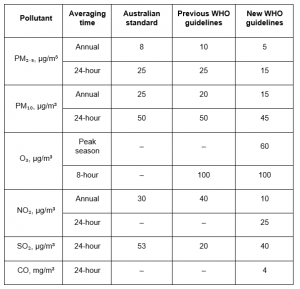The World Health Organisation (WHO) has released new air quality guidelines that significantly lower recommended exposure levels.
For the 2.7 million Australians with asthma, air pollution is a major health risk. Exposure to poor air quality is directly linked to breathing difficulty, hospitalisations and in some cases, premature death.
These new guidelines respond to the strong body of evidence that air pollution affects different aspects of our health at even lower levels than previously thought. This evidence shows there is no “safe” level of exposure to air pollution. For people with asthma, this may not come as a surprise.
This is the first update in 15 years, how do we compare here in Australia?
These new global guidelines are set to challenge what we consider acceptable air quality here in Australia. One of the major shifts is that the WHO has lowered air quality guidelines for fine particulate matter (referred to as PM2.5) for exposure over 24hrs down from 25ug/m3 to 15 ug/m3. The current Australian standard for PM2.5 reflects the previous WHO guideline.
Here are how the new levels look:

Note: In some instances a standard may exist for a different averaging period.
Who is responsible for air quality regulation in Australia?
The policy decision for air quality regulation is a shared responsibility between federal, state and territory governments. The new WHO guidelines are not binding for any nation, and it is up to individual governments whether they take on the recommendations.
What is PM2.5?
Despite whether the source of PM2.5 is human activity or from the environment, PM2.5 is a very concerning pollutant as it can reach the lower lungs, causing health impacts that extend beyond respiratory symptoms to cardiovascular symptoms. Usual sources include smoke from fires including woodfire heater smoke, bushfires, hazard reduction burns; car and truck exhaust, industry-related pollution.
Even low-level exposure is damaging and can accelerate disease states in the body. In many parts of Australia during the winter months, woodfire heater smoke is a major human source of PM2.5. In some cities, it’s the main source of air pollution during winter. Our communities also experience bushfire smoke from hazard reduction burning, a key strategy in our nation’s fire management practices.
What is Asthma Australia doing?
Asthma Australia strongly supports the lowering of air pollution thresholds for the better health of all Australians.
Our Asthma Week 2021 Air Nutrition campaign aimed to encourage Australians to think about what is in the air they breathe. It also revealed in 2021 some communities in Australia have already been exposed to peak hourly levels of PM2.5 exceeding 400ug/m3.
We are currently working towards releasing an ‘AirSmart’ public education campaign to help support individuals to respond to poor air quality events.
To find out more about air pollution, visit our Air Nutrition campaign page here.





 1800 278 462
1800 278 462



